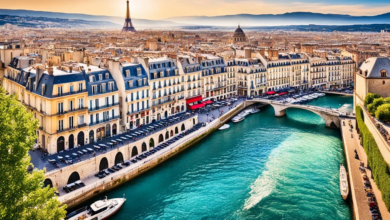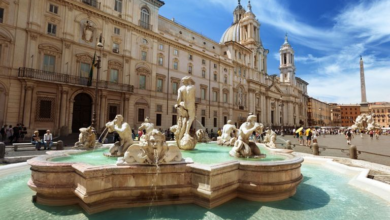Exploring the Solomon Islands: A Traveler’s Guide to Travel and Tourism
Introduction
The Solomon Islands, an archipelago of nearly 1,000 islands in the South Pacific, is a paradise of pristine beaches, vibrant cultures, and breathtaking natural beauty. Often overlooked by mainstream tourists, this hidden gem offers a unique and authentic experience for those seeking adventure, relaxation, and cultural immersion. This article explores the wonders of travel and tourism in the Solomon Islands, providing a comprehensive traveler’s guide and insights into transportation between cities and islands.
The Allure of the Solomon Islands
Natural Beauty
The Solomon Islands are a haven for nature enthusiasts and adventurers.
- Beaches and Marine Life: The islands boast some of the most untouched beaches and vibrant coral reefs in the world. Marovo Lagoon in the Western Province is a UNESCO World Heritage site renowned for its stunning underwater biodiversity, making it a prime spot for diving and snorkeling.
- Rainforests and Waterfalls: The lush rainforests are home to an array of wildlife and cascading waterfalls. Mataniko Falls and Tenaru Falls near Honiara offer picturesque hiking opportunities.
Cultural Richness
The Solomon Islands are rich in history and tradition.
- Traditional Villages: Visiting traditional villages provides a glimpse into the lifestyle and customs of the local Melanesian people. Engage with locals, watch traditional dances, and learn about their crafts and way of life.
- World War II History: The islands played a significant role in World War II, with many historical sites and relics to explore. Guadalcanal, the site of a major battle, has numerous war memorials and museums.
Adventure and Activities
From water sports to trekking, the Solomon Islands offer diverse activities.
- Diving and Snorkeling: With crystal-clear waters and abundant marine life, the Solomon Islands are a diver’s paradise. The SS President Coolidge wreck in Espiritu Santo and the coral gardens of Gizo are must-visit sites.
- Kayaking and Sailing: Explore the islands by sea, kayaking through lagoons and sailing between islands. The New Georgia Islands are particularly popular for these activities.
A Traveler’s Guide to the Solomon Islands
Planning Your Trip
- Best Time to Visit: The ideal time to visit is during the dry season, from May to October, when the weather is cooler and less humid.
- Research and Booking: Use travel websites like TripAdvisor, Booking.com, and Expedia to research accommodations and activities. Consider staying in a mix of resorts, eco-lodges, and guesthouses to experience different facets of Solomon Islands hospitality.
Navigating the Solomon Islands
- Domestic Flights: The islands are connected by domestic flights operated by Solomon Airlines. Regular flights connect the capital, Honiara, with major islands like Gizo, Munda, and Auki.
- Ferries and Boats: Inter-island ferries and boats are a common and scenic way to travel between islands. Companies like Pelican Express and Fair Glory offer services between major destinations.
- Local Transport: In towns like Honiara, taxis and minibuses are widely available. Renting a car or scooter can offer flexibility, especially for exploring at your own pace. Bicycles are also a popular way to navigate smaller islands.
Embracing the Experience
To truly appreciate the Solomon Islands, immerse yourself in its culture and natural beauty.
- Cultural Sensitivity: Respect local customs and traditions. When visiting villages, dress modestly and participate in customary practices with an open heart. Always ask for permission before taking photos of people or their property.
- Connecting with Locals: Engage with the friendly Solomon Islanders and learn about their way of life. Attend community events, try local foods like poi and ulu, and support local artisans by purchasing handmade crafts.
Practical Tips
- Health and Safety: Ensure you have travel insurance that covers health emergencies. Drink bottled or filtered water and stay hydrated, especially in the tropical heat. Be aware of your surroundings and secure your belongings, although the Solomon Islands are generally safe.
- Packing Essentials: Pack lightweight clothing, comfortable shoes, and essentials like sunscreen and insect repellent. A waterproof bag can be handy for beach and water activities.
- Currency and Payments: The local currency is the Solomon Islands Dollar (SBD). Credit cards are accepted in major hotels and restaurants, but having cash is useful for markets and small businesses.
Transportation Between Cities and Islands
Honiara
- Exploring Honiara: The capital city, Honiara, is the gateway to the Solomon Islands. Visit the National Museum, explore the Central Market, and relax at Bonegi Beach.
- Local Transport: Taxis and minibuses are common in Honiara.

Navigating inter-island transportation options in the Solomon Islands can be an adventure in itself. Here are some ways travelers can navigate transportation between major cities in the Solomon Islands:
- Domestic Flights: Domestic flights are the most convenient and fastest way to travel between major cities in the Solomon Islands. Solomon Airlines is the national carrier that operates flights between Honiara (the capital) and other major airports such as Gizo, Munda, Seghe, and Auki. It’s advisable to book flights in advance, especially during peak travel seasons, as schedules can be limited.
- Ferries and Boats: Inter-island travel by ferry or boat is another option, particularly for shorter distances or when flights are not available. The Solomon Islands has a network of passenger ferries that connect various islands. For example, the MV Taimareho operates between Honiara and Auki, while other vessels serve routes like Honiara to Malaita or Honiara to Western Province. Be aware that schedules can be irregular, and it’s recommended to check in advance with local operators for the latest information.
- Charter Boats: For more remote or less serviced islands, chartering a boat may be necessary. There are charter operators available in the Solomon Islands that can arrange private boat transfers or tours to specific destinations according to your itinerary. This option offers flexibility, but it can be more expensive and requires prior planning.
- Public Buses and Taxis: Within major cities like Honiara, public buses and taxis are common modes of transportation for getting around. However, they may not be as readily available for inter-island travel. Public buses can be crowded and operate on set routes within the city. Taxis are usually metered, but it’s advisable to negotiate fares in advance. These options are more suitable for local transportation rather than long-distance inter-island travel.
When navigating inter-island transportation in the Solomon Islands, it’s important to be flexible and patient. Schedules and services can be subject to change due to weather conditions, maintenance, or other factors. It’s recommended to plan ahead, check with local operators for up-to-date information, and allow for contingencies in your travel itinerary.

When using inter-island transportation in the Solomon Islands, it’s important for travelers to be aware of certain safety considerations and take necessary precautions. Here are some tips to keep in mind:
- Weather Conditions: The Solomon Islands can experience unpredictable weather, including tropical storms and cyclones. Before embarking on any inter-island journey, check the weather forecast and be prepared for possible disruptions or delays. It’s advisable to follow the guidance of local authorities and transportation providers regarding travel advisories related to adverse weather conditions.
- Sea Travel: If you plan to travel by ferry or boat, be aware that sea conditions can vary. Some routes may involve open ocean crossings, which can be rough at times. Pay attention to safety briefings provided by the boat operators and follow their instructions regarding life jacket usage and emergency procedures. If you’re prone to seasickness, consider taking appropriate medications or remedies.
- Safety Equipment: Ensure that the boats or ferries you travel on have necessary safety equipment such as life jackets, fire extinguishers, and emergency communication devices. Familiarize yourself with the location and usage of these safety items. If you have any concerns about safety equipment, bring them to the attention of the boat operator or crew.
- Navigation and Local Advice: Inter-island travel in the Solomon Islands may involve navigating through channels, reefs, or shallow waters. It’s recommended to rely on experienced local captains or operators who are familiar with the area and navigational challenges. Seek advice from local experts or authorities regarding safe routes and any specific precautions to be taken.
- Travel Insurance: It’s highly recommended to have comprehensive travel insurance that covers medical emergencies, trip cancellations, and other unforeseen circumstances. Ensure that your insurance policy includes coverage for inter-island transportation and activities specific to the Solomon Islands.
- Personal Safety: Practice general safety precautions when traveling, such as keeping your belongings secure, being aware of your surroundings, and avoiding isolated or unfamiliar areas. If using public transportation within cities, choose licensed taxis or reputable operators. It’s advisable to travel with a companion whenever possible, especially during night journeys or in remote areas.
- Communication and Emergency Contacts: Carry a mobile phone with local network coverage or a satellite phone if traveling to more remote areas. Save important contact numbers, including emergency services, local authorities, accommodations, and transportation providers. Inform someone trustworthy about your travel plans and expected return time.
By being mindful of these safety considerations and taking appropriate precautions, you can enhance your inter-island travel experience in the Solomon Islands while prioritizing your well-being. Always stay informed, exercise caution, and follow the guidance of local authorities and transportation providers for a safe journey.
To ensure safety when booking inter-island transportation in the Solomon Islands, travelers can follow these guidelines:
- Research Reputable Operators: Conduct thorough research to identify reputable transportation operators in the Solomon Islands. Look for reviews, recommendations, and feedback from other travelers. Check if the operator is licensed and adheres to safety standards. Reputable operators prioritize passenger safety and have a track record of reliable service.
- Seek Local Advice: Consult with local tourism offices, accommodations, or travel agencies for recommendations on reliable transportation providers. They can provide up-to-date information on reputable operators and help you make informed decisions based on your specific travel needs.
- Verify Safety Measures: Inquire about the safety measures and equipment provided by the transportation operator. Ensure that their vessels or aircraft comply with safety regulations and have necessary safety equipment such as life jackets, emergency communication devices, and first aid kits.
- Check Insurance Coverage: Confirm that your travel insurance policy covers inter-island transportation activities in the Solomon Islands. Review the policy details to ensure it includes medical emergencies, trip cancellations, and other relevant aspects. If necessary, consider purchasing additional coverage for specific activities or modes of transportation.
- Inquire about Experience and Training: Ask about the qualifications, experience, and training of the boat captains, pilots, or drivers associated with the transportation operator. Experienced personnel who are knowledgeable about local conditions and navigation increase the safety of your journey.
- Understand Cancellation and Refund Policies: Familiarize yourself with the cancellation and refund policies of the transportation operator. Inquire about their procedures in case of trip cancellations, delays, or changes due to weather or other unforeseen circumstances. Clear communication and understanding of these policies will help you manage any disruptions effectively.
- Stay Informed about Travel Advisories: Stay updated on travel advisories issued by local authorities, tourism offices, or embassies. These advisories may provide important safety information or warnings regarding specific inter-island routes or operators. Adjust your plans accordingly based on the recommendations provided.
- Trust Your Instincts: If something feels unsafe or if you have concerns about a particular transportation option, trust your instincts. It’s better to choose a safer alternative or consult with local experts for advice.
Remember, safety is a priority, and it’s crucial to choose transportation options and operators that prioritize passenger well-being. By conducting thorough research, seeking local advice, and verifying safety measures, you can increase the likelihood of a safe and enjoyable inter-island travel experience in the Solomon Islands.

In the Solomon Islands, the most common modes of inter-island transportation include:
- Domestic Flights: Domestic flights are a popular mode of inter-island transportation, especially for longer distances. Solomon Airlines, the national carrier, operates scheduled flights between major cities and airports such as Honiara, Gizo, Munda, Seghe, and Auki. Flights are relatively fast and convenient, connecting different islands within the archipelago.
- Passenger Ferries: Passenger ferries are widely used for inter-island travel in the Solomon Islands. They provide a means of transportation between islands and are particularly common for shorter distances. These ferries are designed to carry passengers, cargo, and sometimes vehicles. They offer an opportunity to enjoy scenic views of the surrounding islands and waters during the journey.
- Charter Boats: For more remote or less serviced islands, chartering a boat is a common option. Travelers can arrange private boat transfers or tours to reach specific destinations according to their itineraries. Charter boats provide flexibility and access to more secluded locations, allowing visitors to explore the diverse island landscape.
- Outboard Motorboats: Outboard motorboats, locally known as “banana boats,” are commonly used for transportation between islands and within local communities. They are small, open boats powered by outboard motors. These boats serve as a primary means of transportation for short distances, especially in areas where larger ferries or scheduled services are not available.
- Canoes: Traditional canoes, known as “dugout canoes,” are still used by locals for inter-island transportation, particularly in more remote areas. These canoes are carved from a single tree trunk and are often powered by paddling or sail. While less common for tourist travel, they are an integral part of local culture and can provide an authentic experience for those willing to explore traditional modes of transportation.
It’s important to note that the availability and frequency of transportation options may vary depending on the specific island or route. Some islands may have limited or irregular transportation services, so it’s advisable to plan your travel in advance and consider the logistics of inter-island transportation when exploring the Solomon Islands.



